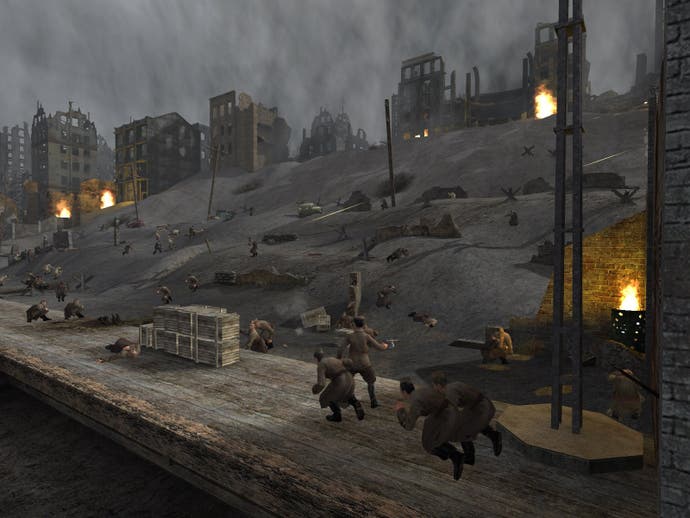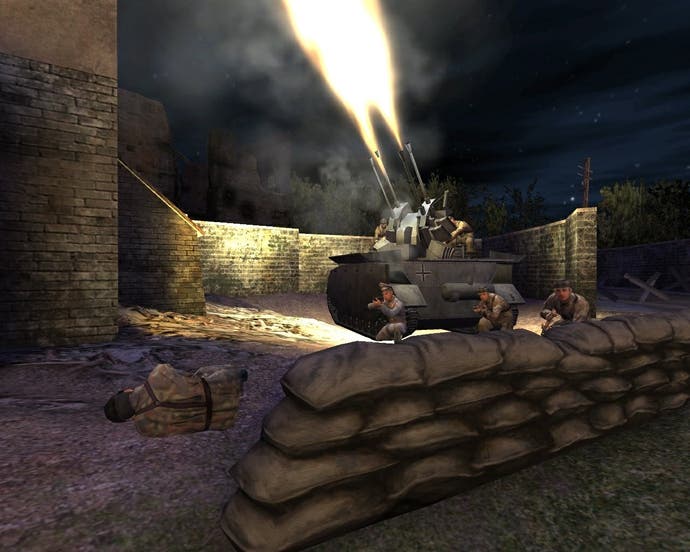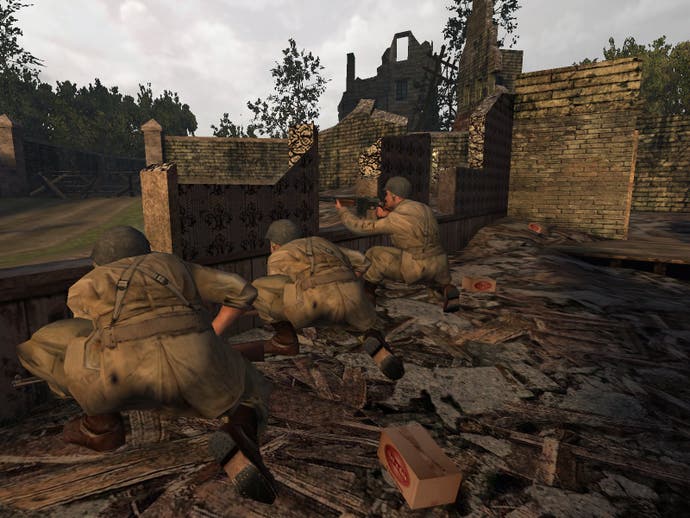Call Of Duty
Allied Assault with big shiny knobs on.
For many publishers, the forthcoming release of Half-Life 2 represents a curse; a giant unassailable commercial monolith that towers so colossally over the PC games market so comprehensively that it's hardly worth bothering trying to release a competing title anywhere near it. Except if you're Activision and you've got Call Of Duty up your sleeves.
Developed by Infinity Ward, a 2015 breakaway team comprised of 22 of the chaps that worked on Allied Assault a couple of years back, this spiritual sequel to EA's monster hit revisits the intense battlegrounds of WWII from multiple perspectives (American, British, and Russian) and basically advances the incredibly overused sub-genre into even more cinematic territory.
It's Quake III tech, but not as we know it

Despite its Quake 3 engine origins, you'd swear it was new tech. Infinity Ward has "kicked out everything" and basically re-written numerous elements of Id's now ageing engine to the point of being almost unrecognisable, much like Valve did with the original Quake code. It comes at a price, though, with a hardware T&L card the minimum entry requirement, but it's now possible for the team to up the ante with an engine capable of rendering a chaotic 300 soldiers on the screen at once.
At the Activate demonstration, with full 5.1 surround sound and a giant plasma screen to hammer home the point, Call Of Duty was regarded by the consensus as among one of the most visually and aurally impressive titles ever witnessed. And like the very best titles in this genre (yes, including Half-Life 2), it features some truly impressive and immersive sequences destined to remain lodged in the brain long after its release.
Now close to its October release Infinity Ward's Grant Collier showed off the intention to make the game "as large and in your face as possible". In one sequence, you're part of a 200 strong squad rushing the enemy, watching your friends die around you as mortar fire explodes everywhere. Imagine the opening sequence in Saving Private Ryan (again), only this time done with a more realistic number of soldiers ducking and diving, complemented by smarter AI, vastly improved character models, relentless chatter, and massively impressive sound effects that will have you wincing.
Not so artificial

Predictably, Infinity Ward is at pains to talk up the AI prowess ("your squad will act like a trained military unit"), and reckons such basics as pathfinding have been totally overhauled, giving players much more control over what's going on around them. For example if you see an AI soldier occupying a gun emplacement, you can get him to move to one side and allow you the honour of raking the enemy with lead. Not only that, but the displaced AI fellow will take up an appropriate stance and cover position, using whatever shattered part of the environment he can to return fire and avoid the enemy's. Better still, your squaddies will call for reinforcements, lay down suppressing fire, provide covering fire, co-ordinate attacks on entrenched positions and even pull wounded soldiers from the melee. Sounds 'armless enough [groan].
In motion, it looks like a series of stitched together scripted sequences, but in fact the soldiers consistently react smartly to what's going on rather than hobble around like headless chickens cannon fodder as they tended to in Allied Assault. Equally pleasing is the unobtrusiveness of the AI, with soldiers seemingly no longer blocking your path or being clueless loons in the worst possible situations. If it plays as good as it looks, we're all in for a treat.
As previously touched upon, a welcome enhancement is the constant AI chatter. Allied Assault built on the Half-Life legacy of giving the player the impression of AI personality, but it tended to be obviously scripted and quite sparsely used. In Call Of Duty, the sequences we were shown were constantly alive to the sound of non-repetitive snatches of conversation and the living breathing fear of death at every turn. It really does add another layer of cinematic credibility and immersion to an already convincing-looking game, and those with a decent surround set up will be shortly experiencing one of the most incredible aural showcases videogaming has ever come up with.
Multi-headed war machine

The game itself follows four interconnected campaigns across 24 missions in eight countries which promise to offer plenty of variety. Kicking off in the boots of an American paratrooper in the 101st Airborne Division laying the groundwork for D-Day, the lead role eventually switches to that of a British Special Forces 6th Airborne troop attacking Pegasus Bridge, before climaxing in the "bloody charge" to defend Stalingrad against the Germans as a Russian Tank commander, via forests, villages, a P.O.W. camp, bridges, sewers and a battleship.
The multiple perspective concept is certainly something of a first in the World War II FPS arena, and should lend it a pleasant change of emphasis, and/or weaponry as you progress. 22 "precisely modelled" weapons make it into the game, specific to each country. Meanwhile the various locales such as Brecourt, Stalingrad and Berlin are all historically accurate, not the mention the numerous vehicles and sound samples. And even better was the fact that each solider in the game has a name, which pops up if your cursor strays over them, showing their rank to boot.
Sadly, we didn't get a hands-on playtest, but the team was on hand to guide us though one of the Brit missions where your squad has infiltrated a dam ready for its destruction. The scene of you and your men riding in the back of a truck was pure Allied Assault, as was the usual banter. On arrival at a vantage point, the task was to take out the advancing Panzer Faust with a sniper rifle, which is heading your way across a bridge. All familiar stuff, granted, but the sense of atmosphere was very impressive indeed. For one thing it was impossible not to be seduced by the glorious attention to detail in both the audio and visual departments, with the rocky snow-capped forest environment rendered in exquisite detail, and supplemented with the sound of chirping birds and the throaty roar of your vehicle's engine.
Harrowing
To wrap things up, we were treated to a quick demo of the very last level of the game, set in Red Square. The ruinous environment was again superbly recreated, and the mission involves taking out the entrenched Germans with a rushing formation through the square, involving plenty of close quarters combat allowing you to rifle butt your foes in the chops. They'll do the same thing to you, mind, so you've got to have your wits about you. Once again, the scene was alive with action, with a red flag carrying warrior falling to his death, fantastically convincing explosions and tremendously detailed texturing all around. Sadly, multiplayer was not discussed, and we await full details in the coming weeks.
Truly, Call Of Duty is a game all FPS fans will want to own upon its release on the PC in October. A unique console version will be released next Spring - also coded by an EA breakaway team, this time the talent behind Frontline, so expect big things from that too. Meanwhile, we're keeping our fingers crossed that playable code will be made available in the run up to its release, and we'll bring you our first impressions as soon as humanly possible.




.png?width=291&height=164&fit=crop&quality=80&format=jpg&auto=webp)




.jpg?width=291&height=164&fit=crop&quality=80&format=jpg&auto=webp)
